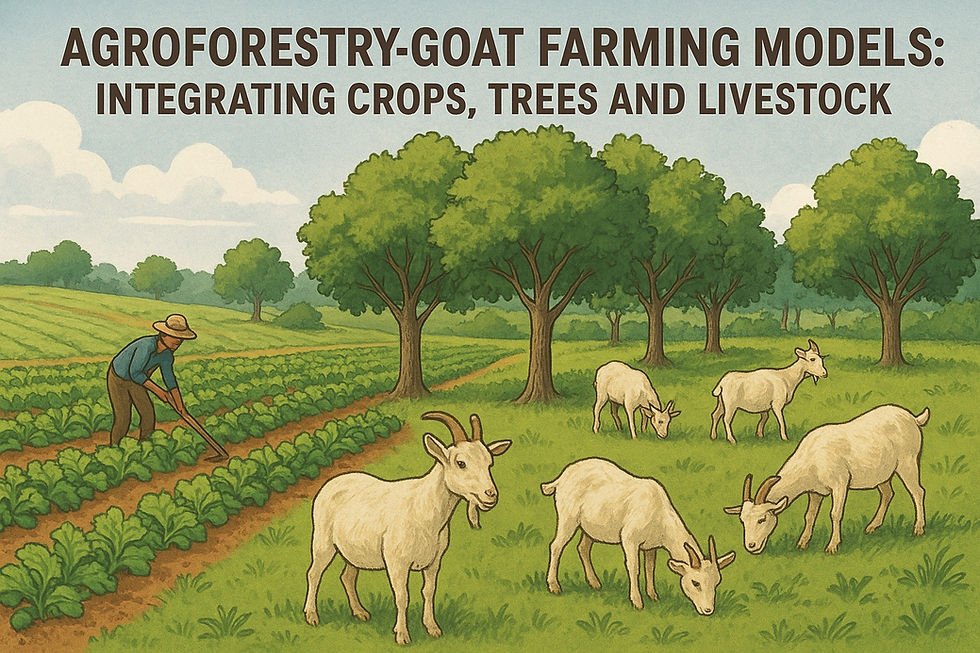Alternate Feeding Strategy for Goats in Drought-Prone Areas of India
- Global Services TGT
- May 9
- 2 min read
Goat farming plays a vital role in supporting rural livelihoods, especially in drought-prone regions of India such as Rajasthan, Maharashtra, Gujarat, parts of Karnataka, and Andhra Pradesh. Goats are known for their adaptability and resilience to harsh environments, but recurrent droughts severely affect fodder availability, compromising their health, productivity, and the overall income of goat farmers.
To ensure sustainable goat farming in these regions, alternate feeding strategies become crucial. These strategies help maintain animal nutrition during feed scarcity and improve drought resilience.
Utilization of Non-Conventional Feed Resources
During drought, traditional green fodder is scarce. Several non-conventional feed sources can be used effectively:
Tree Leaves: Leaves of neem, babul, subabul (Leucaena), banyan, and ber trees are rich in nutrients and can serve as a major part of the diet.
Pods and Seeds: Prosopis juliflora pods, acacia pods, and tamarind seeds are available in arid areas and provide good energy.
Agricultural By-products: Crop residues like wheat straw, paddy straw, sugarcane tops, and groundnut haulms are commonly used, especially when supplemented with urea-molasses treatment to improve digestibility.
Fodder Preservation Techniques
To ensure feed availability during drought, preserving surplus fodder from the rainy season is critical:
Silage Making: Green fodder (like maize, sorghum, or hybrid Napier) can be preserved through ensiling for off-season use.
Hay Making: Drying and storing legumes like lucerne and stylo santhes during the growing season provides nutritious hay for dry months.
Complete Feed Blocks and Pellets
Complete feed blocks or pellets made from a mix of crop residues, oil cakes, bran, mineral mix and molasses are compact, easy to transport, and nutritionally balanced. These are ideal for use during drought and can be prepared locally or purchased from cooperatives.
Fodder Trees and Agroforestry
Promoting fodder tree plantations under agroforestry systems ensures long-term feed security. Perennial species such as subabul, gliricidia, and moringa not only provide nutritious foliage year-round but also help conserve soil from erosion and water.
Drought-Tolerant Fodder Crops
Cultivation of hardy, drought-resistant fodder varieties like Cenchrus ciliaris, Stylosanthes hamata, Guinea grass, and Pearl millet (Bajra) can provide good yields even under moisture stress conditions.
Supplementary Feeding
During critical periods, supplementation with:
Urea-molasses-mineral blocks (UMMBs)
Concentrates with bypass protein and energy
Salt licks and mineral mixtures
helps maintain body condition, reproduction, and milk yield in goats.
Community Fodder Banks
Establishing community-level fodder banks supported by local self-help groups or panchayats ensures equitable fodder distribution during droughts. These banks can stock silage, hay, and feed blocks.
Policy and Extension Support
Training and awareness: Farmers need to be trained in feed preservation, ration balancing, and alternative feed use.
Subsidies and incentives: Government support for silage pits, fodder seeds, and compiling feed block units is essential.
Linking with Krishi Vigyan Kendras (KVKs) and livestock extension centers can help disseminate best practices.
In drought-prone areas, goat farming remains a lifeline for millions. Alternate feeding strategies that are affordable, locally available, and nutritionally adequate are key to sustaining productivity during feed-scarce periods. A combination of traditional knowledge and scientific intervention can ensure resilience and profitability in goat farming under challenging climatic conditions.



Comments